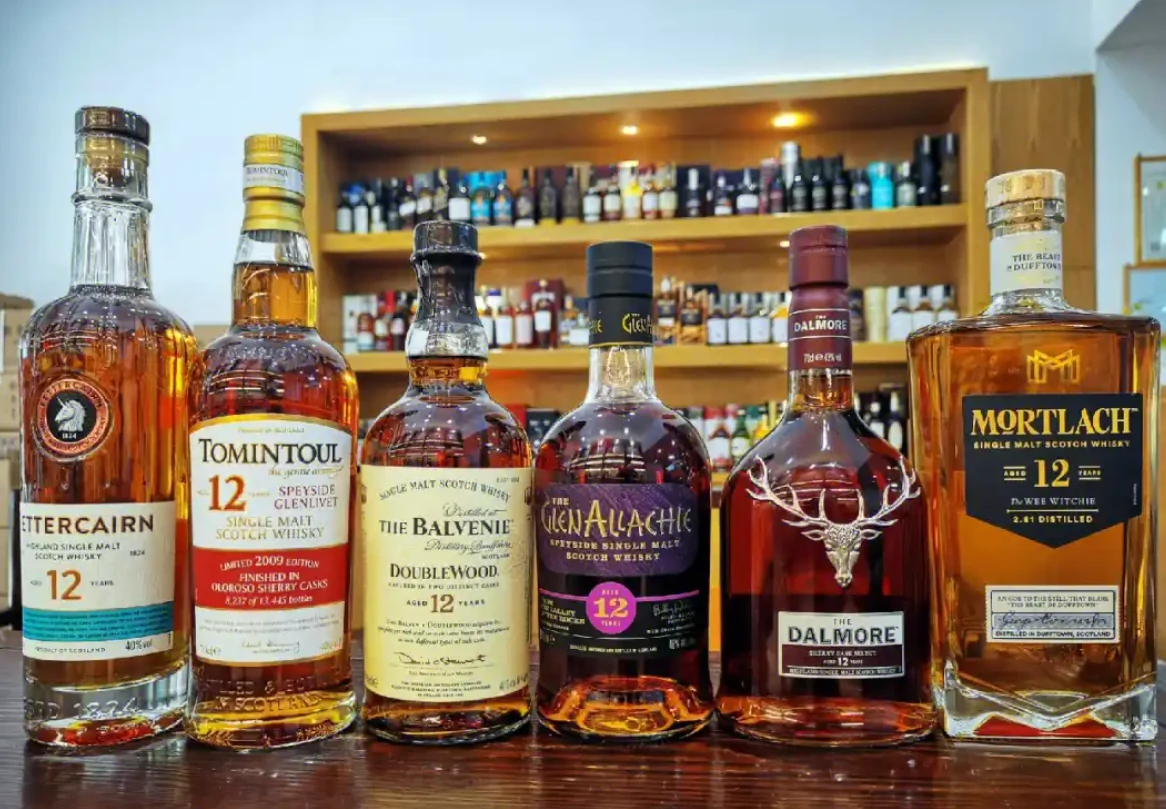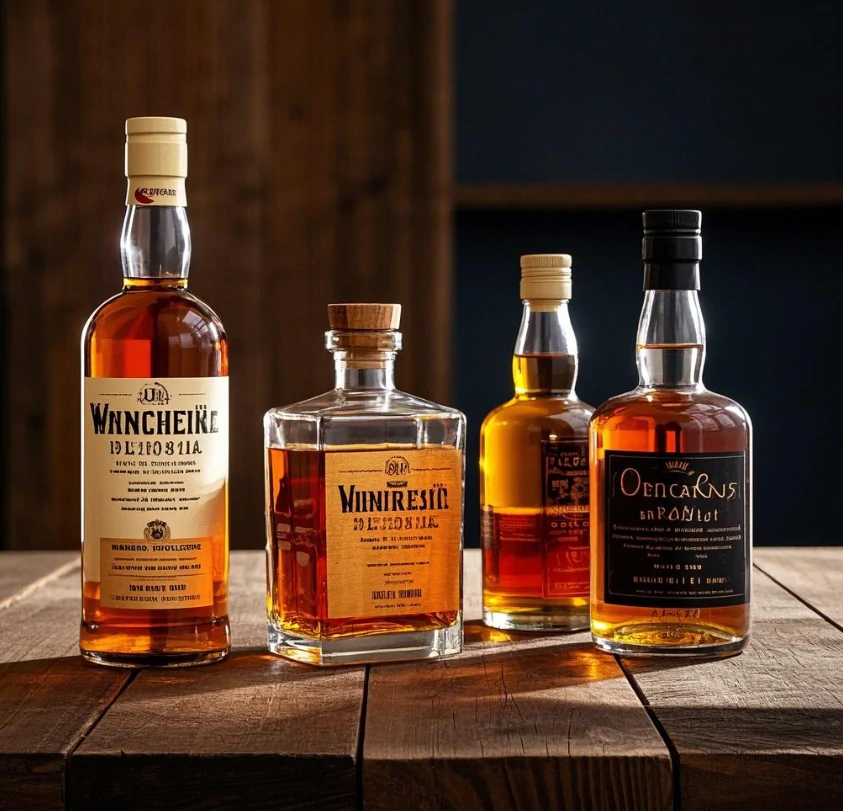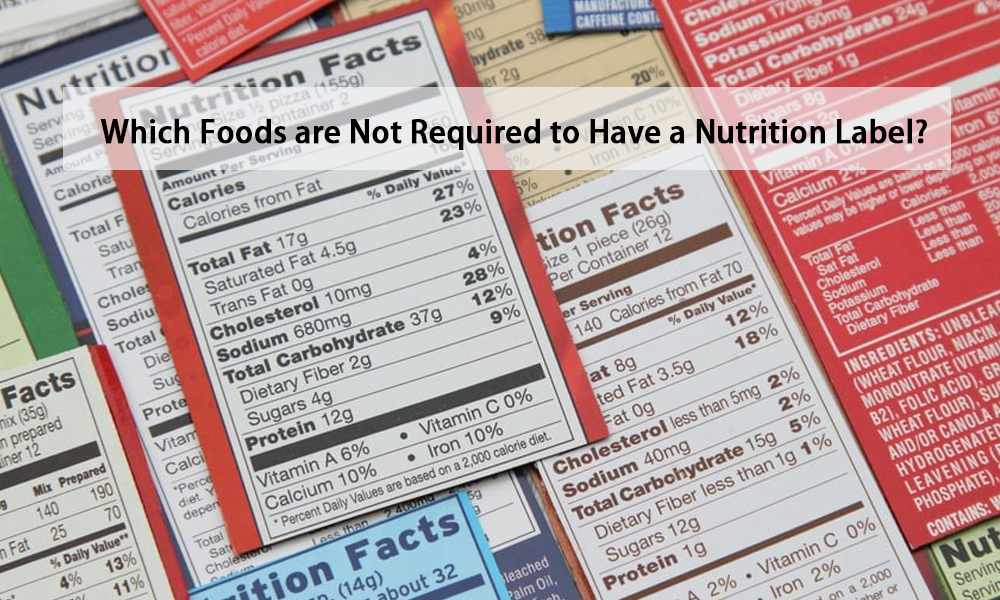
The labels on whiskey bottles contain a lot of key information to help consumers understand the characteristics of the whiskey, its origin, and the process of making it. Here are some common labels and their meanings:
Brand name and distillery information
- Brand name: This is one of the most important identifiers of whisky, indicating the brand or distillery name of the whisky. The brand represents the whisky’s distilling tradition, style and reputation for quality. The “Macallan” brand, for example, is known for producing high-quality single malt whisky, and its brand name reminds consumers of the brand’s consistent level of craftsmanship and flavor profile.
- Distillery information: Some labels will show the name of the distillery where the whisky was produced or a short description of the distillery’s history and distilling methods.
Origin
Origin labels indicate which country or region the whisky comes from. Different origins have different distilling traditions and flavor profiles, and common origin labels are:
- Scotland: e.g. “Scotch Whisky”.
- USA: e.g. “Bourbon” or “Rye Whisky”.
- Ireland: e.g. “Irish Whiskey”.
- Japan: e.g. “Japanese Whisky”.
The place of origin has a great influence on the flavor of the whisky. Whiskies from different countries or regions have their characteristics. For example, Scotch whisky is known for its variety of flavors, including peat smokiness, fruity aromas, and full-bodied taste;
Irish whiskey usually has a softer taste without a strong peat smoky flavor;
American whiskies such as bourbon have strong vanilla, caramel, and oak aromas;
Japanese whiskies are known for their delicate and subtle flavors.
The origin information on the label such as “Scotland” and “Ireland” can help consumers quickly understand the general style of whisky.
Alcohol by Volume (ABV)
Alcohol by Volume (ABV) indicates the amount of alcohol in a whisky, usually expressed as a percentage (%). Typical whiskies have an ABV of between 40% and 50%, but there are some specialty whiskies (such as Cask Strength) that have a higher ABV. Alcohol content affects how a whisky tastes and how it is consumed. Higher alcohol content whiskies usually have a stronger flavor and a stronger kick in the mouth.

Age (Aged)
The label usually indicates how long the whisky has been aged, i.e. how many years it has been in oak barrels. Common age labels include “12 years”, “18 years”, etc., indicating how many years the whisky has been aged in barrels. The older the whiskey, the more complex the flavor profile.
- Vintage Mark (if it is vintage): For whiskies with a vintage mark, this number represents the minimum amount of time the spirit has been aged in oak barrels. For example, “12 Years Aged” indicates that the whiskey has been in oak barrels for at least 12 years. Generally speaking, the longer the aging time, the more the whiskey absorbs the flavors of the oak barrels, the more mellow and complex the taste may be, and the higher the price may be.
- NAS – No Age Statement: Some whiskies have no age statement. This may be due to the distillery using a blend of different vintages, or a desire to highlight other characteristics of the spirit rather than the year of aging. These whiskies also vary in quality and flavor, and some are made in pursuit of unique flavor combinations that are not limited by vintage.
Ingredients for distillation
The main ingredient in whiskey is usually grains. The label may list the type of ingredient, such as barley, corn, rye, etc. Different ratios of ingredients affect the flavor of the whiskey. Bourbon, for example, requires a minimum of 51% corn, an ingredient composition that gives it a strong sweet corn flavor and grain aroma. Help consumers understand the composition of the whiskey. For Single Malt Whisky, the label will clearly state that it is made with 100% malted barley.
Distillation process and flavor description
Distilling process: The label may briefly describe the distilling process of the whiskey, and may mention some key steps in the distilling process, such as the number of distillations and whether it has undergone special filtration treatment. For example, Tennessee whiskey will be filtered through maple charcoal before bottling to make it softer and smoother, and if there is relevant information on the label, it will allow consumers to understand this unique brewing process. For example, whether it is smoked with peat or aged in special oak barrels (e.g. sherry casks).
Flavor description: The label may also indicate the flavor characteristics of the whisky, such as smoky, fruity, vanilla, etc., to help consumers choose the right whisky.
Batch number and date of production
For some limited or special edition whiskies, the label may indicate the batch number and date of production. This helps to trace the production process of the whisky and is especially important for collectible whiskies.
Limited and Special Editions
Limited Edition: The label will usually indicate that this is a limited-production whisky, produced in limited quantities, and may have special packaging or flavors.
Special Editions: Certain whiskies may be specially formulated or released to commemorate an event, and the label will indicate their special nature.
Anti-counterfeiting labels
High-end whiskeys may come with anti-counterfeiting labels to ensure that the consumer is purchasing an authentic product. These labels may include QR codes, unique printed markings, and more.
Labels on whisky bottles are more than just decorative; they contain important information about the whisky, such as origin, ingredients, alcohol content, age, flavor, and distilling process. Consumers can understand the characteristics of whisky through the label and make better purchasing decisions. At the same time, labels are also an important means of brand promotion and product positioning.
Whisky bottle labeling machines
Labeling machines for whisky bottles need to be efficient, accurate, and adaptable to different bottle shapes and sizes, as well as be able to cope with the often specialized surface characteristics of whisky bottles (e.g. curved surfaces, glass bodies, flat surfaces, etc.).
For whisky bottle labeling, the following factors should be considered when selecting a labeling machine:
- Production scale: fully automatic labeling machines are recommended for large-scale production, while semi-automatic labeling machines can be chosen for small batches or small and medium-sized enterprises (SMEs).
- Bottle type: choose the suitable labeling machine according to the shape of the bottle (round, square, straight, etc.).
- Functional requirements: If you need to label bottles or caps at the same time, choose a labeling machine that supports multiple functions such as double-sided and wrap-around.
Below are some types of labeling machines suitable for whisky bottles and recommendations:
Automatic round bottle labeling machine
Scenario: suitable for labeling application on round bottles such as whisky bottles, which can accurately and quickly apply labels to the front or wrap-around portion of the bottle.
Features:
- High speed and efficiency, suitable for high-volume production.
- Precise positioning and bubble-free labeling ensure perfect label fit.
- Adjustable labeling head and bottle spacing to accommodate different-sized bottles.
- Optional barcode printing, production date marking, and other functions.
Semi-automatic round bottle labeling machine
Scenario: suitable for small batch production, easy to operate, suitable for labeling round bottles such as whiskey bottles.
Features:
- Cost-effective, suitable for small and medium-scale production.
- Simple operation, suitable for small business or start-up brands.
- Label alignment is accurate, avoid label warping and bubbles.
FAQ
The numbers typically represent the alcohol by volume (ABV) percentage and the age of the whiskey (e.g., 12 years, 18 years). Some bottles may also include batch numbers, bottling dates, or specific distillation details.
When reading a whiskey bottle, focus on the following key details:Brand Name: The whiskey brand or distillery.
Origin: The country or region where the whiskey was made.
Alcohol by Volume (ABV): The percentage of alcohol in the bottle.
Age: The number of years the whiskey has been aged in barrels.
Ingredients and Production Method: Sometimes, the label will mention the raw materials used and the distillation process.
Flavor Notes: Descriptions like smoky, fruity, etc.
B28 typically refers to the batch number or bottling date. It helps trace the specific production batch or bottling time for quality control and tracking purposes.
The best way to label whiskey bottles is to use high-quality labeling machines that ensure precision and consistency. For whiskey bottles, it is important to choose machines that can handle glass surfaces, curved bottle shapes, and high-speed production. A wrap-around labeling machine is often ideal for full-bottle coverage, while front-and-back labeling machines are suitable for placing labels on both sides of the bottle. Additionally, choosing durable labels made from materials that can withstand moisture, light, and handling is crucial for maintaining the label’s appearance over time.
12 usually refers to the age of the whiskey, indicating it has been aged in oak barrels for 12 years. The aging process plays a key role in developing the whiskey’s flavor and complexity, with longer aging often resulting in a richer taste.




